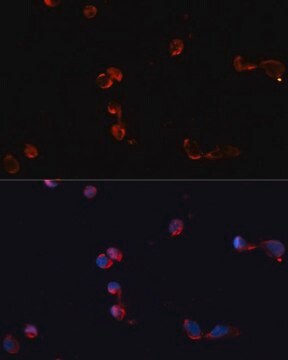C9336
Anti-Chloramphenicol Acetyl Transferase (CAT) antibody produced in rabbit

IgG fraction of antiserum, buffered aqueous solution
Synonym(s):
CAT Antibody - Anti-Chloramphenicol Acetyl Transferase (CAT) antibody produced in rabbit, Cat Antibody
About This Item
Recommended Products
biological source
rabbit
conjugate
unconjugated
antibody form
IgG fraction of antiserum
antibody product type
primary antibodies
clone
polyclonal
form
buffered aqueous solution
mol wt
antigen 26 kDa
enhanced validation
recombinant expression
Learn more about Antibody Enhanced Validation
technique(s)
indirect immunofluorescence: 10 μg/mL using eukaryotic cells transfected with a plasmid bearing the CAT gene
western blot: 10 μg/mL using eukaryotic cells transfected with a plasmid bearing the CAT gene
shipped in
dry ice
storage temp.
−20°C
target post-translational modification
unmodified
General description
Specificity
Immunogen
Application
- immunoblotting
- indirect immunofluorescence
- immunofluorescence microscopy
Biochem/physiol Actions
Anti-Chloramphenicol Acetyl Transferase (CAT) antibody is specific for bacterial CAT and recombinant CAT expressed in transfected eukaryotic cells (a predominant band of approx. 26 kD). Staining of CAT by the antibody is inhibited by the bacterial CAT antigen in cells transfected with CAT.
Physical form
Disclaimer
Not finding the right product?
Try our Product Selector Tool.
Storage Class Code
10 - Combustible liquids
WGK
WGK 3
Flash Point(F)
Not applicable
Flash Point(C)
Not applicable
Certificates of Analysis (COA)
Search for Certificates of Analysis (COA) by entering the products Lot/Batch Number. Lot and Batch Numbers can be found on a product’s label following the words ‘Lot’ or ‘Batch’.
Already Own This Product?
Find documentation for the products that you have recently purchased in the Document Library.
Our team of scientists has experience in all areas of research including Life Science, Material Science, Chemical Synthesis, Chromatography, Analytical and many others.
Contact Technical Service




